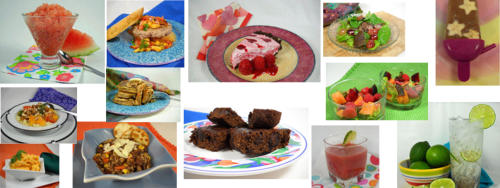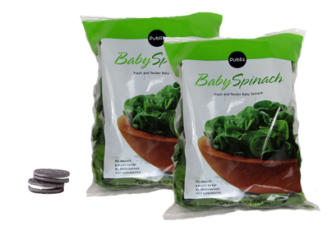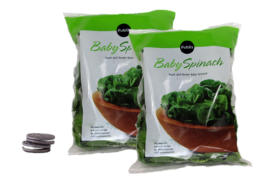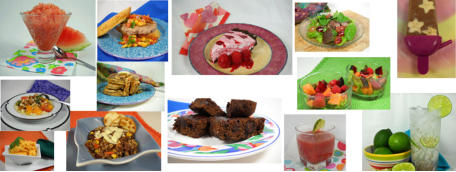



© 2008 www.mychiaseeds.com








What single food can literally make you use up more calories, while helping you feel full faster & stay feeling
satisfied longer? The single answer is unprocessed food…and more specifically…the fiber this particular type
of foods contain. Unprocessed foods are more difficult for your digestive system to break down. It actually
has to work much harder, and this effort burns calories. Your ticket to quick, easy fiber is the chia seed.
Did You Know?
Fiber burns more calories just by being present. This means you can use up to 70
more calories digesting an unprocessed meal, as compared to a highly processed
one.
But…70 calories isn’t that much. Sure, it’s a minor bonus but it’s not going to do a lot by itself.
What’s really here to shine is the ability of unprocessed, fiber-rich foods to make you feel full faster
and stay full longer. This is where chia seeds are the star of the show! Chia is the easy way to add
fiber to food & get the ‘feeling full’ benefits.
Hunger is often a main enemy for people trying to lose weight.
When you’re hungry, you’re more likely to give in to cravings, eat too much of something (that
would have otherwise been fine, if eaten in moderation) or feel run down or low on energy.
Unprocessed foods help with all three issues here, but what exactly are they, and what can you do
to take advantage?
This type of foods includes whole foods (where you eat the whole thing) like fruits, vegetables,
seeds and nuts. But, also included are leafy greens and unprocessed (or low-processed) whole
grains. When you look at how lots of these foods are processed, you can find 1 thing in common:
the removal of fiber. Fruit into juice, wheat into flour, the ‘process’ that’s referred to is taking fiber
out, and sometimes cooking or adding sugars in. So why do they do it? Fiber is often thought of by
manufactuerers as “in the way”. Instead of making recipes with whole foods including their fiber,
the easiest way to smooth texture & good taste is to process it out.
Why is fiber helpful when it isn’t nutritious?
The body can’t break down either kind of fiber (soluble, nor insoluble) for nutrition. It won’t give you any energy, and it
won’t add any calories. It’s this exact ‘doesn’t appear to do much’ property though, that makes it as helpful as it is.
Because it can’t be broken down, it gets in the way instead, slowing down the conversion of carbohydrates into sugars
for steadier energy.
Soluble fiber can’t be used for nutrition by your body, but it can be used by beneficial bacteria (the probiotics in yogurt
& other foods) which then, in turn, protect you from harmful bacteria, extract more nutrients from the food you eat,
and provide a line of defense against viruses. Soluble fiber, by its very name suggests an association with water…and
it’s true, but insoluble fiber also helps with hydration. Both types of fiber, when mixed in with food, keep that food
hydrated all through the digestive process, including the intestines. Good nutrients and bad byproducts are gathered
and dismissed in the intestine…but only if there’s enough water to move the food smoothly.
Taking up space:
Hunger is controlled by a few factors, and a big one is “space”. All food takes up some room as it’s eaten and broken
down by the body…but if someone eats a small, but calorically dense food like a cookie with frosting cream all over it,
that’s not going to take up a lot of room. Hunger could arise again soon after—but it wouldn’t be really ‘justified’
because of all the calories. The body is used to calories that take up space. For an extreme example, can you guess
what two items have about the same amount of calories as a whole pound of spinach?
Did you give it a try?
The answer is just two of the popular cookie brand that starts with O and ends with O & always features cream in the
middle. No one’s going to sit and eat a pound of spinach, but they’ll easily go through more than two of these
sandwich-type cookies. With this example, you can see the true power of fiber to help people feel full and stay that
way.
Now how about taste…
There’s a reason processing is removing fiber from foods & it’s
sometimes about flavor. Whole grain bread with thick texture & wheaty
flavor may not be as appealing to some people as a soft and fluffy white
loaf. Also, from the example earlier, spinach may be fine for a salad but a
couple of cookies are pretty much always going to be more appealing
than handfuls of the stuff. Fortunately, there are plenty of ways to get
around the taste obstacle, and one of the easiest is a seed.
The chia seed is the high fiber seed with so much of both kinds of fiber
that you can actually see it. (Most soluble fiber is so small, its invisible to
the naked eye--but you can see it here in this photo as the hydrated
seeds sit apart from eachother in the spoon) Its other remarkable property is that it has no flavor. Everything else on
the menu is going to taste like something, and that means someone out there won’t like it. However, with chia’s flavor-
free nature you can use it to add fiber to things you already like to eat. Having a white-bread sandwich? Sprinkle a
batch of chia seeds into the PB (for your PB&J) or on the mustard…or really anything where they’ll stick. Now, you get
the bread you prefer and the fiber you need. It’s easy enough to do at any meal, and it even works in cold drinks.
What are unprocessed choices?
Making unprocessed choices can be easy and delicious at any meal. Put oats on the menu for breakfast instead of
boxed cereal, bagels, donuts or pancakes on most days. Whole grain oats are extremely versatile—much more so
than most people suspect. They can create anything from a cool mango-lime smoothie to a warm bowl of chocolate
almond-butter delight when you have the recipes for Overnight Oatmeal. (Completely changes the texture, and
flavors are endless!) Having eggs? They’re good protein, but they’re a fiber-free food, so a sprinkle of chia into the
omelet or scramble will give you the fiber you need to stay full until lunch. Juicing or blending? Juicing removes the
fruit’s fiber but leaves all the sugar. You can achieve the same great flavors in the blender as you can the juicer. The
other option is to juice something that doesn’t blend well (a carrot, or ginger root for example) then add the juice to
your blended drink where you used blender-friendly fruits like apples, mangoes or strawberries and chia seeds.
There are plenty of ways and recipes to help you with unprocessed choices and fiber rich whole foods all over the
internet and in articles. Don’t want to search? Grab loads of great recipes and save time now with our Bonus Chia
Cook Books! Now that you know the benefits of fiber, what foods have more of it, and how it will help you, it’s time to
get it on the menu. But, remember: chia seeds are basically the best way to cheat your way to the top of the daily
value for fiber…but they can’t take care of every nutrient. Colorful fruits, crunchy nuts, fresh or frozen berries and
good grains all combine for more power and better health, because like it or not, you really are what you eat.

How about cutting cravings for unhealthy items?
That’s also something fiber can do, because certain kinds of bad bacteria can create cravings for more of what THEY
want, which may not be good for you. Sugar loving bacteria might release a chemical that your body mistakes for a
signal to eat more sugar. The various signals are called “Microbiome - brain interaction”. The microbiome is the name
of the collective bacteria that live in the digestive system. Fiber feeds good-guy bacteria (the probiotics) and they, in
turn, stamp out the bad bacteria. Also, keeping food moving smoothly through the digestive system doesn’t let the
bad guys have as much of a chance to hang around and disrupt your day with their common side-effects like excess
gas, bloated feelings, & cravings. Keep the beneficial bacteria working hard for you every day! Feed them the fiber
they need.




Each bag pictured here is 6
ounces of spinach. To get 1
pound, you would need about
2/3 of ANOTHER bag! All that,
for just 2 cookies worth of
calories.
Which Food Helps You Feel Full Faster & Stay Full Longer?





© 2008 DBA Design Action MySeeds Chia

What single food can literally make you use up more calories, while helping
you feel full faster & stay feeling satisfied longer? The single answer is
unprocessed food…and more specifically…the fiber this particular type of
foods contain. Unprocessed foods are more difficult for your digestive
system to break down. It actually has to work much harder, and this effort
burns calories. Your ticket to quick, easy fiber is the chia seed.
Did You Know?
But…70 calories isn’t that much. Sure, it’s a minor bonus but it’s not going
to do a lot by itself. What’s really here to shine is the ability of unprocessed,
fiber-rich foods to make you feel full faster and stay full longer. This is
where chia seeds are the star of the show! Chia is the easy way to add fiber
to food & get the ‘feeling full’ benefits.
Hunger is often a main enemy for people trying to lose weight.
When you’re hungry, you’re more likely to give in to cravings, eat too much
of something (that would have otherwise been fine, if eaten in moderation)
or feel run down or low on energy. Unprocessed foods help with all three
issues here, but what exactly are they, and what can you do to take
advantage?
This type of foods includes whole foods (where you eat the whole thing)
like fruits, vegetables, seeds and nuts. But, also included are leafy greens
and unprocessed (or low-processed) whole grains. When you look at how
lots of these foods are processed, you can find 1 thing in common: the
removal of fiber. Fruit into juice, wheat into flour, the ‘process’ that’s
referred to is taking fiber out, and sometimes cooking or adding sugars in.
So why do they do it? Fiber is often thought of by manufactuerers as “in the
way”. Instead of making recipes with whole foods including their fiber, the
easiest way to smooth texture & good taste is to process it out.
Why is fiber helpful when it isn’t nutritious?
The body can’t break down either kind of fiber (soluble, nor insoluble) for
nutrition. It won’t give you any energy, and it won’t add any calories. It’s this
exact ‘doesn’t appear to do much’ property though, that makes it as helpful
as it is. Because it can’t be broken down, it gets in the way instead, slowing
down the conversion of carbohydrates into sugars for steadier energy.
Soluble fiber can’t be used for nutrition by your body, but it can be used by
beneficial bacteria (the probiotics in yogurt & other foods) which then, in
turn, protect you from harmful bacteria, extract more nutrients from the
food you eat, and provide a line of defense against viruses. Soluble fiber, by
its very name suggests an association with water…and it’s true, but
insoluble fiber also helps with hydration. Both types of fiber, when mixed in
with food, keep that food hydrated all through the digestive process,
including the intestines. Good nutrients and bad byproducts are gathered
and dismissed in the intestine…but only if there’s enough water to move
the food smoothly.
Taking up space:
Hunger is controlled by a few factors, and a big one is “space”. All food
takes up some room as it’s eaten and broken down by the body…but if
someone eats a small, but calorically dense food like a cookie with frosting
cream all over it, that’s not going to take up a lot of room. Hunger could
arise again soon after—but it wouldn’t be really ‘justified’ because of all the
calories. The body is used to calories that take up space. For an extreme
example, can you guess what two items have about the same amount
of calories as a whole pound of spinach?

Each bag pictured here is 6
ounces of spinach. To get 1
pound, you would need about
2/3 of ANOTHER bag! All that,
for just 2 cookies worth of
calories.
Did you give it a try?
The answer is just two of the popular cookie brand that starts with O and
ends with O & always features cream in the middle. No one’s going to sit
and eat a pound of spinach, but they’ll easily go through more than two of
these sandwich-type cookies. With this example, you can see the true power
of fiber to help people feel full and stay that way.
How about cutting cravings for unhealthy items?
That’s also something fiber can do, because certain kinds of bad bacteria can
create cravings for more of what THEY want, which may not be good for you.
Sugar loving bacteria might release a chemical that your body mistakes for a
signal to eat more sugar. The various signals are called “Microbiome - brain
interaction”. The microbiome is the name of the collective bacteria that live
in the digestive system. Fiber feeds good-guy bacteria (the probiotics) and
they, in turn, stamp out the bad bacteria. Also, keeping food moving
smoothly through the digestive system doesn’t let the bad guys have as
much of a chance to hang around and disrupt your day with their common
side-effects like excess gas, bloated feelings, & cravings. Keep the beneficial
bacteria working hard for you every day! Feed them the fiber they need.
Now how about taste…
There’s a reason processing
is removing fiber from foods
& it’s sometimes about
flavor. Whole grain bread
with thick texture & wheaty
flavor may not be as
appealing to some people as
a soft and fluffy white loaf.
Also, from the example
earlier, spinach may be fine
for a salad but a couple of cookies are pretty much always going to be more
appealing than handfuls of the stuff. Fortunately, there are plenty of ways
to get around the taste obstacle, and one of the easiest is a seed.
The chia seed is the high fiber seed with so much of both kinds of fiber that
you can actually see it. (Most soluble fiber is so small, its invisible to the
naked eye--but you can see it here in this photo as the hydrated seeds sit
apart from eachother in the spoon) Its other remarkable property is that it
has no flavor. Everything else on the menu is going to taste like something,
and that means someone out there won’t like it. However, with chia’s flavor-
free nature you can use it to add fiber to things you already like to eat.
Having a white-bread sandwich? Sprinkle a batch of chia seeds into the PB
(for your PB&J) or on the mustard…or really anything where they’ll stick.
Now, you get the bread you prefer and the fiber you need. It’s easy enough
to do at any meal, and it even works in cold drinks.


What are unprocessed choices?
Making unprocessed choices can be easy and delicious at any meal. Put
oats on the menu for breakfast instead of boxed cereal, bagels, donuts or
pancakes on most days. Whole grain oats are extremely versatile—much
more so than most people suspect. They can create anything from a cool
mango-lime smoothie to a warm bowl of chocolate almond-butter delight
when you have the recipes for Overnight Oatmeal. (Completely changes the
texture, and flavors are endless!) Having eggs? They’re good protein, but
they’re a fiber-free food, so a sprinkle of chia into the omelet or scramble
will give you the fiber you need to stay full until lunch. Juicing or blending?
Juicing removes the fruit’s fiber but leaves all the sugar. You can achieve the
same great flavors in the blender as you can the juicer. The other option is
to juice something that doesn’t blend well (a carrot, or ginger root for
example) then add the juice to your blended drink where you used blender-
friendly fruits like apples, mangoes or strawberries and chia seeds.
There are plenty of ways and recipes to help you with unprocessed choices
and fiber rich whole foods all over the internet and in articles. Don’t want to
search? Grab loads of great recipes and save time now with our Bonus Chia
Cook Books! Now that you know the benefits of fiber, what foods have more
of it, and how it will help you, it’s time to get it on the menu. But, remember:
chia seeds are basically the best way to cheat your way to the top of the
daily value for fiber…but they can’t take care of every nutrient. Colorful
fruits, crunchy nuts, fresh or frozen berries and good grains all combine for
more power and better health, because like it or not, you really are what
you eat.
Fiber burns more calories just by being present. This means you can
use up to 70 more calories digesting an unprocessed meal, as
compared to a highly processed one.








